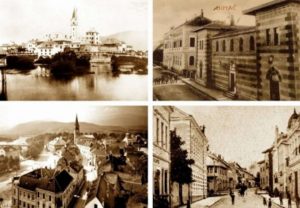Besides Sarajevo and Jajce, no other Bosnian town is as historically interesting as Bihac.
In the town center are numerous cultural and historical monuments that are bear witnesses to its rich history, interwoven with different cultures, customs, and religions.
There is not enough data on how Bihac looked in the 13th century. Historians know that in this period town had seven churches, including the largest city church of St. Antun.
“Based on recent data, particularly those from the 16th century, it can be concluded that Bihac was built on an artificial island, surrounded by walls with round and rectangular loopholes. Bihac fortress had a conical roof, which is visible from the medieval coat of arms. The town had entrances through three gates: those towards Izacic, Zavalj and Una. Based on the contents of one document from the late 14th century, it is evident that the seal of medieval Bihac consists of three towers and the middle one had a flag. The same motif had a medieval coat of arms of the city of Bihac,” says Juric.
Since the history of the city is interwoven with different cultures, religions, and customs, each of these cultures left an indelible mark on it.
Cultural and historical heritage makes Bihac attractive to lovers of universal values. Captain’s Tower, St. Antun of Padua, once one of the largest Catholic places of worship, turbe that dates from the Austro-Hungarian occupation of Bihac (built in honor of the fallen defenders of the city), mosque Fethija and walls that still defy time are recalling the old days of pride and glory, and these are the most valuable cultural and historical monuments in the center of town.
When you walk past the mausoleum that is located on the tower of the former Catholic church and next to graves of Bihac nobles and knights, the first thing to ask yourself is who is buried here and who built this tomb.
Midzic says the founder and builder of this tomb is Mehmed Pasha Biscevic, the captain of Bihac, and the information that he was the creator of this work can be found in the magazine Nada from 1901.
There are several historic monuments of great value in the town. These monuments, along with the remains of walls that once surrounded the city while protecting it from the invasion of the enemy, are witnesses of turbulent, but the heroic history of Bihac.
It is not surprising that these monuments attract curious tourists who visit Bihac and Krajina because of its natural beauty, but also the cultural values that are a combination of the multinational identity of Bihac.
(Source: Radiosarajevo.ba)


